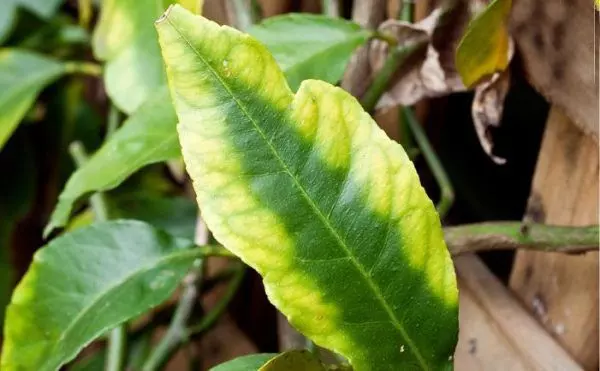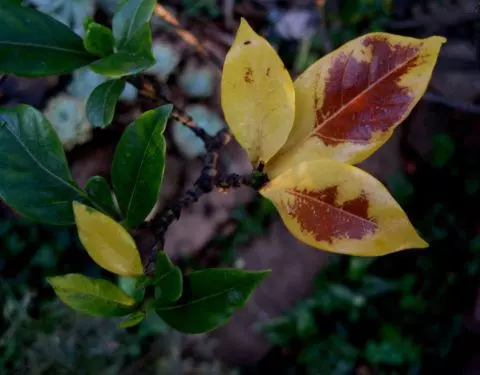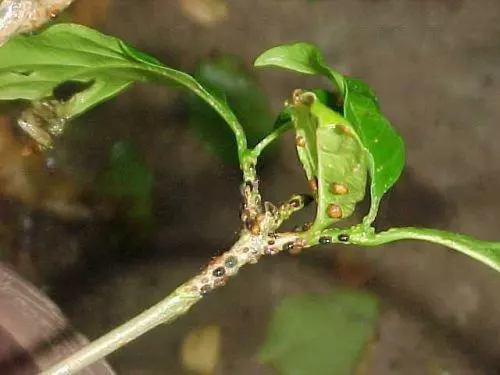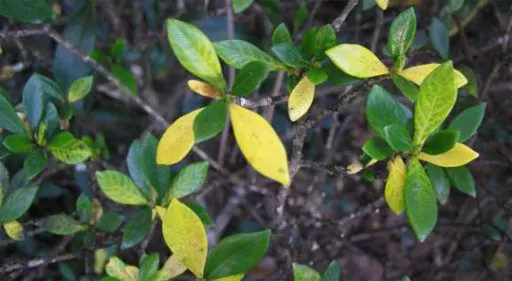Is there a sudden appearance of yellow leaves on a gardenia plant? If you have seen some yellowing leaves, do not worry. This article summarizes the possible causes with pictures for a diagnosis and how to fix the yellowing leaves on a gardenia, including the information you need to choose a suitable fertilizer for gardenias with yellow leaves.
Chlorosis is a problem in which the amount of chlorophyll in the leaves is reduced. Chlorophyll is a pigment in plants’ young leaves and stems, giving them their characteristic green color. When the content of this pigment decreases, leaves appear yellow, brown, or even white in some cases.
While there can be a variety of causes why gardenias show yellow leaves, the most common are overwatering, mineral deficiencies, and insufficient sunlight. Below are the most common causes of yellow leaves on gardenia and some remedies to stop this yellowing.
Table of Contents
Yellowing Leaves on a Gardenia
Several factors may cause the presence of yellow leaves on gardenia. The most common ones include:
- Sunburn
- Insects
- Drought
- Improper watering
- Nutrient deficiency (especially magnesium and iron)
- Bacterial or fungal disease
Throughout this article, you will learn all about yellow leaves on gardenia. We will also explain what you need to know when choosing a suitable fertilizer to fix gardenias with yellow leaves.
Yellow Leaves on Gardenias Due to Magnesium Deficiency
A lack of magnesium may be one of the causes of yellowing leaves on a gardenia plant. The picture below will help you understand why the leaves turn yellow on your gardenia. The yellowing will be seen outside the leaf, and the center will remain green (picture below). As you can see, not the entire leave remains yellow. That is a clear indicator of magnesium deficiency.
To fix yellow leaves on gardenia due to magnesium deficiency, you can add a fertilizer that is rich in magnesium or use Epsom salts.

Gardenia Yellow Leaves Due to Iron Deficiency
Iron deficiency can also cause yellow leaves on gardenia. The leaves are very similar to magnesium deficiency.
The solution to yellow leaves in gardenias due to lack of iron is to add iron powder (for plants) or some fertilizer that has plenty of iron. Apply once every two to four weeks.
Learn more about What is ferrous sulfate iron used for?
- GOODBYE YELLOW, HELLO LUSH GREEN LEAVES - Grow More iron chelate for plants is rich in organic ingredients, formulated to swiftly banish the yellowing leaves due to iron deficiency. Quickly notice the restoration of your plants' natural green color
- TREATS 2,000 SQUARE FEET - Gardening savvy meets cost-effectiveness with this ultra-concentrated formula giving you the most bang for your buck! Just mix with water following the recommended dosage, and enjoy numerous applications with this generous 8-ounce size
- VERSATILE FOR ANY ENVIRONMENT - Perfect for either indoor or outdoor spaces, our chelated iron fertilizer is most effective when applied to both soil and foliage, offering a flexible solution to combat iron deficiency with ease. Tailor its application to your plant's unique needs following our instructions for optimally healthy growth
Why Are the Leaves Turning Yellow on My Gardenia: Excess Fertilizer
Also, excess fertilizers are terrible for gardenia plants and may cause yellowing leaves or/and brown leaves (spotted or not), as shown in the picture below. One must have a balance with the nutrients that it provides to the plant. Too much fertilizer can burn the root of the plant, and where it will be almost impossible to save the gardenia plant. We recommend this fertilizer for gardenias.
- Organic granular for decreasing soils alkalinity; provides acid-loving plants with all natural Sulphur
- Omri listed for organic gardening by USDA; certified organic means no synthetic chemicals
- Ideal formula for hydrangeas and blueberries; turns hydrangeas from pink to blue; test soil pH before applying

Gardenia Pests
Pests such as mealybugs and aphids are also to blame for yellow leaves on gardenia. These pests usually suck the sap from the plants and leave a sticky secretion that causes a fungus to grow, which blocks sunlight, so the plant does not photosynthesize properly.
Some of the most common gardenia pests are aphids, spider mites, mealybugs, and whiteflies. Aphids are small insects that feed on the sap of plants and cause them to wither. Spider mites are tiny creatures that live on the underside of leaves and suck out their juices. Mealybugs are also insects, but they secrete a sugary substance called honeydew which turns into mold and attracts more pests like ants. Whiteflies lay eggs in new growths, which then hatch into larvae which cause stunted growths, yellowing leaves, wilting, and dying plants in some cases.
The solution to combat the pests in gardenias with yellow leaves is to use neem oil or an organic pesticide to eliminate these pests as soon as possible from the plant.

Recommended Post: How and When to Prune Gardenias
Excess Watering
Too much water can cause yellow leaves on gardenia, so controlling the amount of water is essential. If the plant is in the ground directly, stop watering for a few days, but if it is in a pot, it is best to change some soil so that the roots do not rot.
Gardenia is an acidophilus plant. Therefore, it requires an acid substrate. A pH of around 5 may be sufficient for the gardenia to absorb nutrients normally. Otherwise, its leaves will turn from green to yellow. Learn more about how to measure soil pH.

Fertilizer for Gardenias with Yellow Leaves
Fertilizer for gardenias with yellow leaves. Fertilize your gardenias every 15 days in spring and summer with liquid fertilizer dissolved in the irrigation water. If possible, use special fertilizer for acidophilus plants, that is, plants such as hydrangeas, azaleas, heather, etc., that need acid soil.
Gardenia requires fertilizers rich in phosphorus and potassium and those that give acidity to the soil. The most suitable fertilizer for gardenias with yellow leaves is 3-1-2 or 9-13-11. Granular fertilizers should be applied once a month or, if they are liquid fertilizers, every 15 to 20 days.
When we refer to 3-1-2 (or any number), we mean Nitrogen, Potassium, and Phosphorus (NPK). Learn more about different types of fertilizer.
Gardenias need strongly acid soil, so from time to time, you should use a fertilizer rich in iron (e.g. iron chelates), especially if the leaves turn yellow, which is a sign that they lack this nutrient. Learn more about what is the best fertilizer for gardenias.
- VIBRANT GROWTH — Fertilizing Your Gardenia Leads to More Consistent Blooms, AND a Deeper Flower and Foliage Colors
- BIG PLANTS — Filled With Essential Nutrients that Your Flowering Plant Needs to Grow Big And Strong
- SPECIALLY FORMULATED — NPK and Application Instructions Are Specific To Flowering Bushes, Potted and in the Landscape
Why Are the Leaves Turning Yellow on My Gardenia: Final Conclusions
Let’s see a couple of final thoughts to answer a popular question regarding gardeners: Why Are the Leaves Turning Yellow on My Gardenia?
As discussed in this article, there are several causes behind the appearance of yellowing leaves on gardenias. We recommend that you never overwater your gardenia plants and control the fertilizers so you do not over-fertilize. However, the lack of nutrients such as magnesium and iron is among the most common causes. Instead of over-fertilize your gardenia, observe the yellow leave, is it remain green in the center, or is it entirely yellow? That will help you decide how to fix a sudden appearance of yellowing leaves due to a lack of magnesium when the center of the gardenia leaves remains green or a lack of iron when the entire leaves turn yellow.
However, remember that the sudden appearance of yellowing leaves may also be caused by incorrect soil pH, which affects nutrient absorption even if the soil is rich in nutrients. Gardenia is an acidophilus plant that needs a soil pH above 5 to absorb the soil nutrient properly. Although the nutritional requirements are demanding, like any flowering plant, fertilizing is as essential as ensuring the soil pH is correct. Otherwise, the plant’s roots may be damaged.
Hopefully, this note about yellow leaves on gardenia will significantly help you solve the problems with your plant.



